Monday, May 27th 2019

AMD Announces 3rd Generation Ryzen Desktop Processors
AMD CEO Dr. Lisa Su at her 2019 Computex keynote address announced the 3rd generation Ryzen desktop processor family, which leverages the company's Zen 2 microarchitecture, and are built on the 7 nm silicon fabrication process at TSMC. Designed for the AM4 CPU socket, with backwards compatibility for older AMD 300-series and 400-series chipset motherboards, these processors are multi-chip modules of up to two 8-core "Zen 2" CPU chiplets, and a 14 nm I/O controller die that packs the dual-channel DDR4 memory controller and PCI-Express gen 4.0 root complex, along with some SoC connectivity. AMD claims an IPC increase of 15 percent over Zen 1, and higher clock speeds leveraging 7 nm, which add up to significantly higher performance over the current generation. AMD bolstered the core's FPU (floating-point unit), and doubled the cache sizes.
AMD unveiled three high-end SKUs for now, the $329 Ryzen 7 3700X, the $399 Ryzen 7 3800X, and the $499 Ryzen 9 3900X. The 3700X and 3800X are 8-core/16-thread parts with a single CPU chiplet. The 3700X is clocked at 3.60 GHz with 4.40 GHz maximum boost frequency, just 65 Watts TDP and will be beat Intel's Core i7-9700K both at gaming and productivity. The 3800X tops that with 3.90 GHz nominal, 4.50 GHz boost, 105W TDP, and beat the Core i9-9900K at gaming and productivity. AMD went a step further at launched the new Ryzen 9 brand with the 3900X, which is a 12-core/24-thread processor clocked at 3.80 GHz, which 4.60 boost, 72 MB of total cache, 105W TDP, and performance that not only beats the i9-9900K, but also the i9-9920X 12-core/24-thread HEDT processor despite two fewer memory channels. AMD focused on gaming performance with Zen 2, with wider FPU, improved branch prediction, and several micro-architectural improvements contributing to a per-core performance that's higher than Intel's. The processors go on sale on 7/7/2019.When paired with an AMD X570 chipset motherboard, these processors make up the world's first PCI-Express gen 4.0 based desktop platform. PCIe gen 4.0 doubles per-lane data bandwidth to 16 Gbps. The Ryzen 3000 "Zen 2" processor puts out 24 PCIe gen 4.0 lanes externally, from which 16 lanes are meant for graphics cards, 4 lanes for an M.2 NVMe slot, and 4 as chipset-bus. The X570 chipset puts out 16 downstream PCIe gen 4.0 lanes, which means up to two additional M.2 slots, and more onboard connectivity. The total platform PCIe lane budget has shot up to 40 lanes, all of which are gen 4.0. AMD put out 3DMark PCIe bandwidth feature-test performance numbers comparing a Radeon RX 5700 "Navi" graphics cards on a Ryzen 7 3800X vs. an RTX 2080 Ti a PCIe gen 3.0 platform powered by Core i9-9900K. The performance was significantly higher.Much of AMD's engineering effort with Zen 2 has been to increase the CPU core's overall math performance, which translated to higher IPC (by 15 percent), increased per-core performance, and conversely higher gaming performance. AMD put out some astonishing gaming performance numbers, in which it compared a 3800X to its own 2700X from the previous generation. You see a staggering 22 percent increase in PUBG frame-rates, and up to 34 percent increase in CS:GO. This may look like insignificant e-Sports titles as opposed to the big AAA ones, but give valuable insights to the chip's gaming prowess. We're convinced that Zen 2 will be faster than any Intel processor at gaming when it comes out.
AMD unveiled three high-end SKUs for now, the $329 Ryzen 7 3700X, the $399 Ryzen 7 3800X, and the $499 Ryzen 9 3900X. The 3700X and 3800X are 8-core/16-thread parts with a single CPU chiplet. The 3700X is clocked at 3.60 GHz with 4.40 GHz maximum boost frequency, just 65 Watts TDP and will be beat Intel's Core i7-9700K both at gaming and productivity. The 3800X tops that with 3.90 GHz nominal, 4.50 GHz boost, 105W TDP, and beat the Core i9-9900K at gaming and productivity. AMD went a step further at launched the new Ryzen 9 brand with the 3900X, which is a 12-core/24-thread processor clocked at 3.80 GHz, which 4.60 boost, 72 MB of total cache, 105W TDP, and performance that not only beats the i9-9900K, but also the i9-9920X 12-core/24-thread HEDT processor despite two fewer memory channels. AMD focused on gaming performance with Zen 2, with wider FPU, improved branch prediction, and several micro-architectural improvements contributing to a per-core performance that's higher than Intel's. The processors go on sale on 7/7/2019.When paired with an AMD X570 chipset motherboard, these processors make up the world's first PCI-Express gen 4.0 based desktop platform. PCIe gen 4.0 doubles per-lane data bandwidth to 16 Gbps. The Ryzen 3000 "Zen 2" processor puts out 24 PCIe gen 4.0 lanes externally, from which 16 lanes are meant for graphics cards, 4 lanes for an M.2 NVMe slot, and 4 as chipset-bus. The X570 chipset puts out 16 downstream PCIe gen 4.0 lanes, which means up to two additional M.2 slots, and more onboard connectivity. The total platform PCIe lane budget has shot up to 40 lanes, all of which are gen 4.0. AMD put out 3DMark PCIe bandwidth feature-test performance numbers comparing a Radeon RX 5700 "Navi" graphics cards on a Ryzen 7 3800X vs. an RTX 2080 Ti a PCIe gen 3.0 platform powered by Core i9-9900K. The performance was significantly higher.Much of AMD's engineering effort with Zen 2 has been to increase the CPU core's overall math performance, which translated to higher IPC (by 15 percent), increased per-core performance, and conversely higher gaming performance. AMD put out some astonishing gaming performance numbers, in which it compared a 3800X to its own 2700X from the previous generation. You see a staggering 22 percent increase in PUBG frame-rates, and up to 34 percent increase in CS:GO. This may look like insignificant e-Sports titles as opposed to the big AAA ones, but give valuable insights to the chip's gaming prowess. We're convinced that Zen 2 will be faster than any Intel processor at gaming when it comes out.
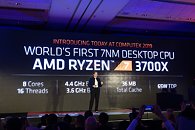
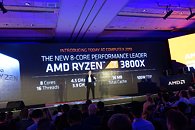
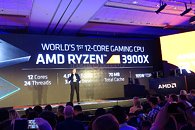
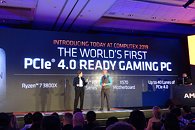


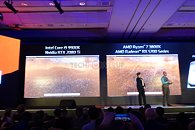
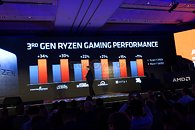
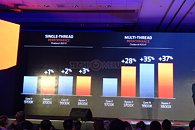
95 Comments on AMD Announces 3rd Generation Ryzen Desktop Processors
And there is a lesson to be learned here. Whenever someone claims to know the final clocks and pricing several months ahead of release, you can know it's fake, because the bins are decided after the final stepping returns and then the final clocks and pricing are decided. And it doesn't matter if it's AMD, Intel or Nvidia. We heard the same kind of BS leading all the way up to the release of Turing too.
(P.S. there is nothing wrong in speculating as long as it's not claimed as fact)
I'm glad AMD at least published some specs to put an end to the extreme rumors. If expectations are too high, it will actually hurt them.First of all, TDP is usually in steps, so two "105W" CPUs might have different consumption, even if it's the same brand.
Secondly, the top models will be based on higher binned chips.Ice Lake has been ready for almost two years. The lack of microarchitecture is not the problem, the lack of a suitable node is.Zen(1) and Zen+ is so close that it shouldn't matter that much, the 3% gain of Zen+ was sort of a best case.
While I assume the "15%" claim is a bit of a best case, I hope it's not like when Intel says 15% and it really is more like 5%.
3700X = 9700K and 3800X = 9900K in gaming performance for $100 less and much less power consumption? Very nice.
I mean you guys still not learn after all these years I guess. After the ADoredTV fiasco confirmed in the last hours, you now believe that a company could have a beastly gaming CPU that was equa or better than their Rival, and they wouldn´t spam graphs about it while promoting their product. Come on.
They didn´t hesistate a single bit to put graphs about cinebench and other productivity taks vs Intel, do you really think if Zen 2 was better than Intel for gaming, they woudn´t spam graphs about it?
Now I just wish for more mobos with heatpipes on them instead of fans.
2) Why would 7nm deliver higher clock speeds? As with all process nodes like this, it's a mobile-first, low power process node. Getting it to 4,6GHz is quite impressive. I guess we'll see about OC headroom, but even 4.6 OOTB is excellent, as it will at least mean most chips can OC to all-core 4.6GHz (unless they already do so).
3) What does branding matter? Sub-$200 6c12t CPUs don't become any less impressive just because they're branded "5" instead of "3".
4) While I would love the previously rumored prices to be true, that was never realistic. However, your summary here is quite naive. Small chiplets are nice, but 7nm is a far more expensive process than 14nm - rumored to be about 2x$/area. In other words, the chiplets being smaller doesn't matter much - at least not for a while. Then there's the fact that these are now MCM products with a separate I/O die, meaning both a second (relatively large) 14nm die, plus the likely quite noticeable added cost of MCM packaging. As for EOL sales making the new chips look bad? That's ... kind of how clearance sales work. "Ignore the new stuff, this is good too, and look how cheap it is!" Besides, AMD's Ryzen prices have historically always dropped in the months following launch, so there's no reason to expect this not to happen this time around.The chipset isn't 7nm, but 14. Also, it has PCIe 4.0. And 11W for the chipset is rather common, actually (a few years back we had chipsets far, far beyond this) - and can be passively cooled without issue. It seems AMD are being strict with OEMs in terms of maintaining chipset-connected PCIe transfer speeds, which is a good strategy.
2) Why would 7nm deliver higher clock speeds ? Maybe because it's manufacturer #TSMC has been advertising higher clock speeds ? As i said 4,6Ghz is decent but thats roughly + 300Mhz over what was possible with 12nm and 12nm brought around 300Mhz over 14nm , considering there is much bigger gap between TSMC 7nm and GF 12nm than between GF 12nm and 14nm one could reasonably expect a bit higher clocks especialy knowing that core count remained the same . Here again we have to wait and see if those clocks are achievable on all cores and how far they can be bushed if at all but yeah if Zen2 was able to boost at around 4,8Ghz that would had been sweet .
3) Well peoples didn't had to wait for Ryzen 3000 to have 6c12th at sub 200$ , thanks to Ryzen 1000 and 2000 series sub 200$ 6c/12th has been a reality since a long time now so i don't see whats so impressive about this . What i would had called impressive is to have 8c/16th at sub 200$ .
4) Of course 7nm costs more but saying chiplets smaller size doesn't matter much is a huge understatement because smaller size means much more working chips per wafer ( read final products per wafer ) wich compensates alot ( if not overcoming ) for the increased cost in manufacturing process , this is especialy true for higher core counts ( 16c , 32c , 64c etc ) i will give you that but still ! The logic here is that chiplets can truly help AMD to increase their margins on very high end and HTPC segments ( where they can afford to and where the real money is ) without any major impact on the final product price thus allowing them to reduce even further their margins on the mainstream segment where it will show more on the final product price . It would had been a win win situation for all segments but sadly on mainstream segment prices are not really going down . This being said don't get me wrong im not saying pricing is bad , and it will probably get better with time but imo they could had been a bit more aggressive .
Try harder.
Since it is new processors which went through a lot of changes in comparison to precious two Zens.
AMD claims an IPC increase of 15 percent over Zen 1
Any other questions?
15% IPC increase roughly means you can clock 15% lower while having the same performance.
So a 4.5 GHz Zen2 CPU roughly = 5.1 GHz even 5.3 GHz Zen CPU (Depends on using 4.5x1.15 or 4.5 / 0.85 for the equation.)
So imagine a 1800x clocked at 5GHz.
AMD's latest stab at Intel is the "Zen 2" microarchitecture at the heart of the new Ryzen 9 3900X 12-core/24-thread processor, leading a gaming-focused processor lineup that also includes the Ryzen 7 8-core/16-thread, and Ryzen 5 3600X 6-core/12-thread. These processors feature a 10% increase in clock-speeds, and a whopping 15 percent increase in IPC over the current "Zen+" The processors, when combined with motherboards based on the AMD X570 chipset, also put out a total of 40 PCI-Express gen 4.0 lanes. Unlike previous generations, much of AMD's engineering effort has been focused on shoring up gaming performance. The company is explicitly marketing these processors as "Gaming CPUs." The processors launch on the 7th of July.